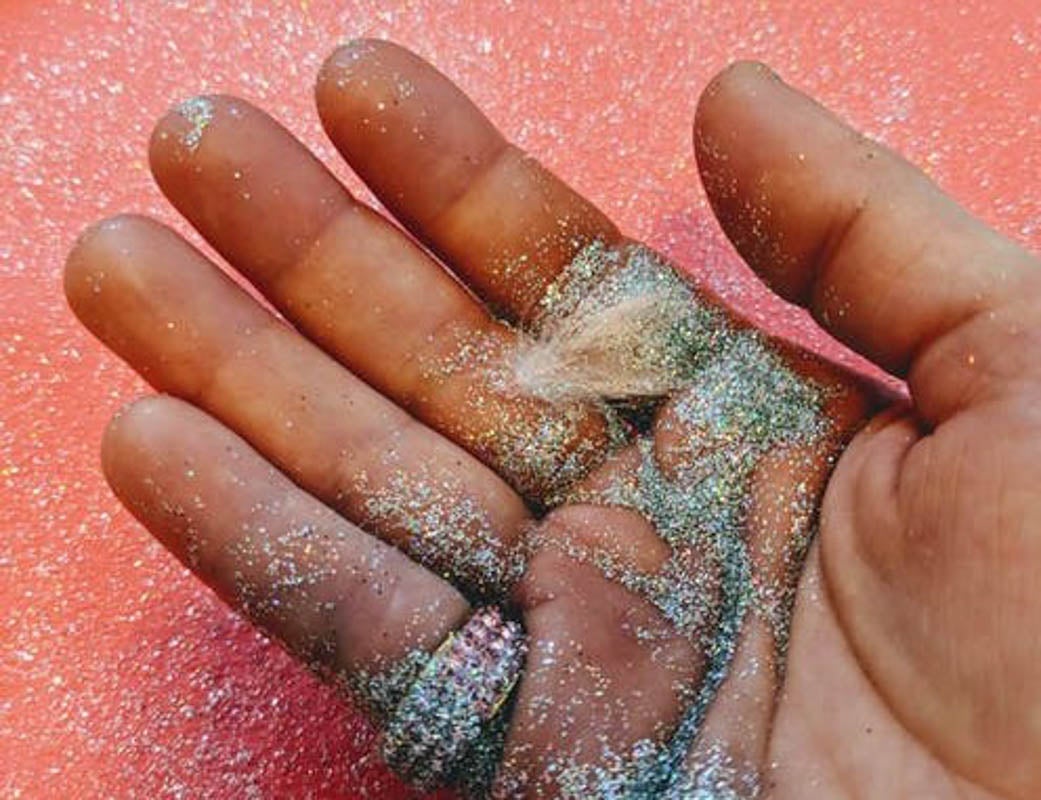In my family of mostly teachers, glitter has been known as the “social virus” of the elementary school arts and crafts closet for years. You can ask any school teacher in the primary grades or go to their house and you will find glitter in totally unexpected – and unwelcomed – places.
Yes, in today’s world many items are single use and made of plastic, but glitter is one of those things that is not necessary and certainly doesn’t serve any useful purpose beyond decoration.
If I could sponsor some useful legislation, I think that I would make sure that things that can’t be recycled, aren’t necessary and pose possible environmental health risks – like glitter! – would never be produced in the first place.
Tons of tiny glitter are produced every year. First, flat multilayered sheets are produced combining plastic, coloring and reflective metallic material. These sheets are then cut into tiny particles of various shapes and sizes.
The purposely small glitter is the perfect size for getting into the water, aquatic wildlife and the natural environment.
In the past few years, a lot of attention has been given to banning single-use plastics of all sorts because they eventually break down into microparticles – the size of glitter and smaller. Particularly, a lot of attention has been given to banning single-use items that aren’t or can’t be recycled. These often are thrown on the ground, into the water and left in the woods. You can see these all over in the environment. You can often see a “bathtub ring” of these items on the shores of our lakes, beaches and waterways. This plastic trash is everywhere! Come on, who recycles glitter?
And the purposely small glitter is the perfect size for getting into the water, aquatic wildlife and the natural environment.
Greeting card companies use tons of it every year. Children in primary grades makes glue-and-glitter projects for different reasons and seasons, such as Valentine’s Day and Mother’s Day. While these cards are certainly appreciated and often saved by mothers and grandmothers everywhere, they still represent a “warm and fuzzy” that could be expressed other ways or by the same means without the glitter.
Just a little bit of this stuff, left unchecked and allowed to enter your house, will be found everywhere. You might find it in your coffee, on your couch and your bed pillows.
Glitter can be so pervasive that there is a forensic scientist who has a collection of glitter consisting of over 1,000 different samples that he uses to compare with samples taken from crime scenes. Glitter particles are easily transferred through the air or by touch, yet cling to bodies and clothing, often unnoticed by suspects.
Scientists have been warning for decades that our unbridled use of petroleum to make everything of plastic would eventually come back to haunt us. As these microparticles are now being found inside of many creatures at the bottom of the food chain and in the ocean flora and fauna. It seems that these same micro particles are now moving up the food chain just as predicted decades ago. I find this eerily similar to the impact of some pesticides on the world’s environmental health and certain declining animal populations.
This shouldn’t surprise. It stands to reason that if you are what you eat, and if what you eat comes out of the water or the ocean, sooner or later it is going to get to us at the top of the food chain.
No one really knows what this portends for our future, but I can’t imagine microparticles being a healthy thing to ingest or inhale. How long will it be before we possibly find out that glitter can be a carcinogen like asbestos or cause silicosis? Sound extreme?
In these times of cataclysmic weather, global warming and enviro-pollution it seems that someone may be intentionally spanking Mother Earth for profit. Let’s think about glitter manufacturers and craft stores that sell glitter. Are the glitter companies making a profit at the expense of our children and grandchildren? Or are they just meeting the needs of an indifferent or uncaring populous?
Why aren’t we individually boycotting glitter?
Roy Lenfest is the primary maintenance technician for the fitness equipment at UCF’s Recreation and Wellness Center. He can be reached at Roy.Lenfest@ucf.edu.
The UCF Forum is a weekly series of opinion columns from faculty, staff and students who serve on a panel for a year. A new column is posted each Wednesday on UCF Today and then broadcast on WUCF-FM (89.9) between 7:50 and 8 a.m. Sunday. (A podcast of this column is available on the radio station’s website.) Opinions expressed are those of the columnists, and are not necessarily shared by the University of Central Florida.




